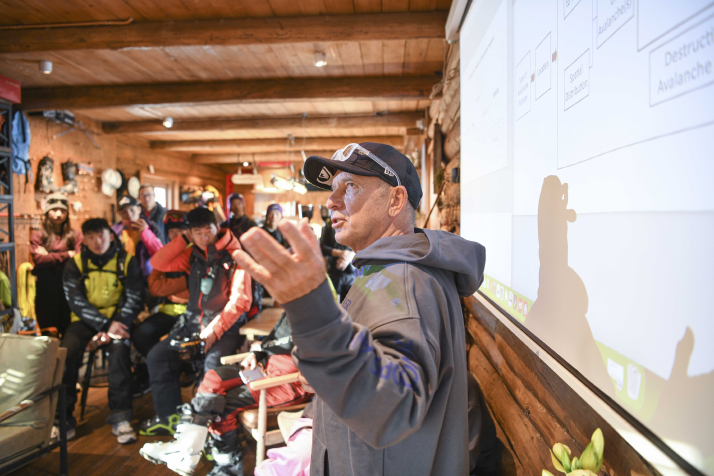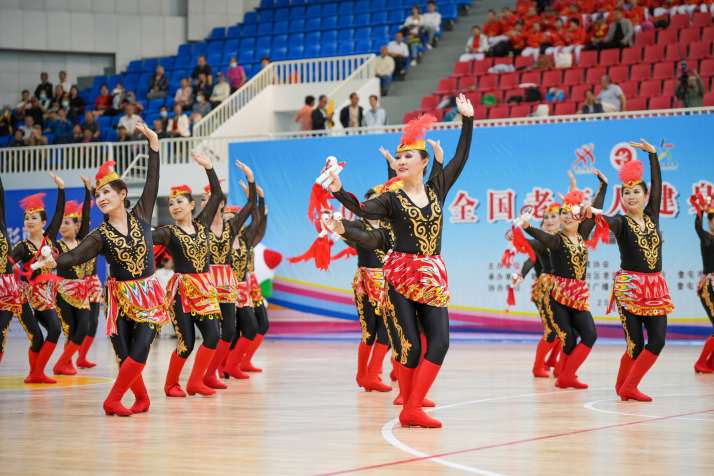| Xinjiang Today |
| Paths through Xinjiang: encounters with openness and diversity | |
|
|
 An expert from New Zealand conducts a skiing technique session in Altay Prefecture on December 3, 2024 (XINHUA)
Opening up is a defining feature of China, and Xinjiang stands as a vital gateway to China's westward engagement. In recent years, the region has accelerated its integration into the Belt and Road Initiative, a China-proposed initiative to boost connectivity along and beyond the ancient Silk Road routes, transforming into a dynamic hub of high-standard opening up and development. From the Urumqi International Land Port Area to the Huoerguosi (Khorgas or Horgos) International Border Cooperation Center, Xinjiang is building channels to connect with the world. The story of Xinjiang's openness is not only told in trade routes and infrastructure, it is seen and felt by those who visit the region. In this series, Xinjiang Today interviewed four international visitors from different professional backgrounds and countries. Their reflections paint a vivid portrait of a region open not just to commerce, but to dialogue, diversity and shared human experience.
Thore Vestby, a former mayor of Frogn Municipality, Norway When I arrived in Xinjiang in late 2019, it was on a whim—a detour driven by curiosity. "You can't go there," many told me. But I went anyway. What I found wasn't the closed, tense place portrayed in headlines. Instead, Xinjiang opened itself up to me, vividly, unapologetically and full of life. Urumqi's International Grand Bazaar, located in Tianshan District in Urumqi and renowned as the world's largest bazaar, was my first experience. The moment I set foot into it, music erupted around me, Uygur rhythms echoing as dancers spun in vibrant traditional costumes. I paused, absorbing the joy. "Is this really Xinjiang?" I asked myself. It was. And it was spectacular. Over the course of six days, I traversed from modern cityscapes to the historic alleys of Kashi (Kashgar). In every corner, the contrasts were striking: deserts reborn as farmland; centuries-old bazaars pulsating with modern energy. I watched artisans craft tea sets, children laugh in multiple dialects and families gather around communal meals rich with spices. Diversity here isn't just tolerated, it's celebrated. Cultural harmony is not an abstract idea in Xinjiang, it's lived. Ethnic groups live side by side, working, trading, dancing, not as a political slogan, but as neighbors. The solidarity felt organic, rooted in shared daily life. Equally remarkable was the infrastructure, gleaming highways snaking across vast grasslands, high-speed trains and bridges that seemed to float across the horizon. Even remote towns were seamlessly connected, a testament to deep investment in regional development. Many overlook the transformation underway here. Agricultural innovation is turning arid land into fruit-bearing fields. Economic initiatives are visibly improving lives. From my conversations and observations, people seemed proud—not just of their heritage, but of the progress they're part of. Regarding China's counter-terrorism policy and efforts, what I witnessed was one focused on stability through education and opportunity. "No one is born a terrorist," a Beijing colleague once told me. In Xinjiang, that belief appears to underpin much of the strategy. This journey transformed my perspective on the region, revealing resilience, joy and openness that defy simplistic narratives. To truly understand Xinjiang, critics should walk its streets, share its meals and engage with its people. I did. And what I found was simple but important: hope. I look forward to returning to see more achievements in the coming years.  Performers demonstrate tendon-stretching exercises at the opening ceremony of a national fitness program at a gymnasium, in Kuitun, Ili Kazak Autonomous Prefecture, on May 27 (XINHUA)
Omar Ibrahim, a Canadian influencer Xinjiang overwhelmed me, in the most beautiful way possible. My first visit to China's northwestern frontier was a journey through a kaleidoscope of culture and color as well as a contradiction to everything I had expected it to be. The places, Urumqi, Kashi, Kuerle (Korla) and Yuli, each carried a distinct personality. Urumqi buzzed with cosmopolitan energy. Kashi enchanted with its ancient bazaars and timeworn alleys. But it was Kuerle, nestled in central Xinjiang at the southern foot of the Tianshan Mountain Range, that surprised me the most: a city I expected to be provincial turned out to be the most visually captivating, bathed in greenery and artful lighting. It felt like walking through a living painting. In Yuli County in south Xinjiang, I stood transfixed before bronze statues of a traditional Uygur band, life-sized and exquisitely detailed, capturing a joy that was palpable. These were not museum relics but part of daily life, public spaces alive with dance, music and multilingual signs. Uygur culture didn't just survive here—it thrived. And it did so with pride. Everywhere I went, from crowded markets to quiet parks, I saw prosperity and ease. Cities were impeccably clean, infrastructure was world-class, and the people, from shopkeepers to farmers, seemed content and connected to their communities. Some of the most striking moments came in places many Westerners might never think to visit: a kindergarten in Kuerle that could rival elite Western schools, where children learned in purpose-built studios and playgrounds that looked like dreamscapes. Nearby, a senior center, up and running for over two decades, organized daily cultural programs. In rural areas, I witnessed agricultural innovation that challenged the very idea of Xinjiang as "underdeveloped." I'd heard the reports: "surveillance, oppression, cultural erasure." But what I saw contradicted those claims. I met Muslim Uygurs in traditional dress, speaking their language openly, running businesses, teaching, praying. At a government-supported Islamic school, hundreds of students were preparing to become scholars, a sight wholly incompatible with the narrative of religious suppression. What I saw wasn't a stage-managed illusion, it was everyday life. A life full of festivals, family, education and growth. I believe Xinjiang is not just misunderstood, it is misrepresented. And as someone who has walked its streets, spoken with its people and seen its progress firsthand, I feel compelled to share this truth: Xinjiang is open, evolving and, above all, human. Najeeb Ullah, an international student from Pakistan studying at Xinjiang Medical University In early 2025, I attended Xinjiang's regional Two Sessions, provincial meetings mirroring national Two Sessions, the annual meetings of the National People's Congress, the country's top legislature, and the Chinese People's Political Consultative Conference National Committee, the political advisory body. Held each January in Urumqi, these sessions set the region's development agenda for the year. As a foreign observer, I was invited alongside students and journalists to see, firsthand, the momentum behind Xinjiang's transformation. The sessions opened with a showcase of achievements: booming agriculture, revitalized manufacturing and a burgeoning tourism sector. Infrastructure was a focal point: brand-new highways, upgraded cityscapes and an expanding transport grid. The message was clear: Xinjiang isn't standing still. It's surging forward. But what impressed me most wasn't just the figures or forecasts. It was the vision. Officials spoke not only of economic goals but of cultural preservation, environmental protection and ethnic harmony. The emphasis on unity, on fostering dialogue among the region's many communities, was woven throughout the sessions. "Development must benefit everyone," one delegate said. "Or it is not true progress." Outside the meeting halls, we visited model agricultural cooperatives, cutting-edge factories and historical sites. These weren't just photo ops—they were proof of policies taking root in everyday lives. Locals spoke candidly of better access to services, education and jobs. Importantly, the government did not gloss over remaining challenges, but addressed them head-on, signaling a commitment to sustainable, inclusive growth. The involvement of international guests like myself added a powerful layer of transparency. We asked questions, we saw behind the headlines. And what emerged was a picture of a region far more complex—and far more hopeful—than the usual caricatures suggest. Xinjiang's Two Sessions told a story not of stagnation or suppression, but of aspiration. What I witnessed was a region rising, with openness, resilience, diversity and a firm eye on the future. Mira Vance, a master's student at Peking University, originally from the United States In Xinjiang, opening up isn't a policy, it is a rhythm. From the moment we arrived, music and dance served as a universal invitation, breaking down barriers and drawing people in. Whether in the streets of Urumqi or a restaurant in Kashi, performances often erupted into full-blown celebrations where tourists, locals and strangers danced side by side. This openness wasn't performative—it was participatory. Senam, the dynamic Uygur dance, was the heartbeat of these gatherings. Dancers in ornate costumes moved with elegance and power, balancing teacups mid-twirl, their expressions full of pride. We weren't just spectators. "Come," they'd gesture, pulling us into the circle. And we went, hesitant at first, then laughing, spinning, clapping to the beat. Cultural diversity was on vivid display—Russian folk music, accordion serenades, and Kazakh performers all found space on Xinjiang's many stages. This was no curated showcase for outsiders. It was an expression of living heritage, thriving in the public sphere. In 2023, the "Xinjiang dance" trend swept Chinese social media, a digital manifestation of this cultural openness. Over 1.6 billion views later, Xinjiang dance became not just a tourist attraction but a symbol of cross-cultural enthusiasm. The region's cultural centers responded by launching online tutorials and dispatching dance ambassadors across the rest of the country—a national embrace of Xinjiang's traditions. In city squares, Xinjiang dance parties welcomed all. Locals taught tourists steps. People recorded their joy, wearing regional costumes, eager to share their experience online. It was messy, real and profoundly human. This wasn't the Xinjiang I'd heard about in political commentary. What I saw was a society confidently sharing itself, with music, movement and the open arms of its people. In every shared dance, Xinjiang's message was clear: This is who we are, and you're welcome to join in. Comments to zhaowei@cicgamericas.com |
|
||||||||||||||||||||||||||||
|